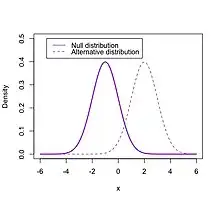虛無假說
在推論統計學中,零假设(英語:,又译,符号:)是做统计检验时的一类假說。
零假设的内容一般是希望能证明为错误的假设,与零假设相对的是對立假說,即希望通过证伪零假设而证明正确的另一种假说。从数学上来看,零假设和备择假设的地位是相等的,但是在统计学的实际运用中,常常需要强调一类假设为应当或期望实现的假设,例如在相关性检验中,一般会取“两者之间无关联”作为零假设,而在独立性检验中,一般会取“两者之间非獨立”作为零假设。
如果一个统计检验的结果拒绝(reject)零假设(结论不支持零假设),而实际上真实的情况属于零假设,那么称这个检验犯了型一錯誤。反之,如果检验结果支持零假设,而实际上真实的情况属于备择假设,那么称这个检验犯了型二錯誤。通常的做法是,在保持第一类错误出现的机会在某个特定水平上的时候(即显著性差异值或α值),尽量减少第二类错误出现的概率。
参考来源
延伸閱讀
- Adèr, H. J.; Mellenbergh, G. J. & Hand, D. J. . Huizen, The Netherlands: Johannes van Kessel Publishing. 2007. ISBN 90-79418-01-3.
- Efron, B. . Journal of the American Statistical Association. 2004, 99 (465): 96. doi:10.1198/016214504000000089. The application of significance testing in this paper is an outlier. Tests to find a null hypothesis? Not trying to show significance, but to find interesting cases?
- Rice, William R.; Gaines, Steven D. . TREE. June 1994, 9 (6): 235–237. doi:10.1016/0169-5347(94)90258-5. Directed tests combine the attributes of one-tailed and two-tailed tests. "...directed tests should be used in virtually all applications where one-sided tests have previously been used, excepting those cases where the data can only deviate from H0, in one direction."
外部連結
This article is issued from Wikipedia. The text is licensed under Creative Commons - Attribution - Sharealike. Additional terms may apply for the media files.
